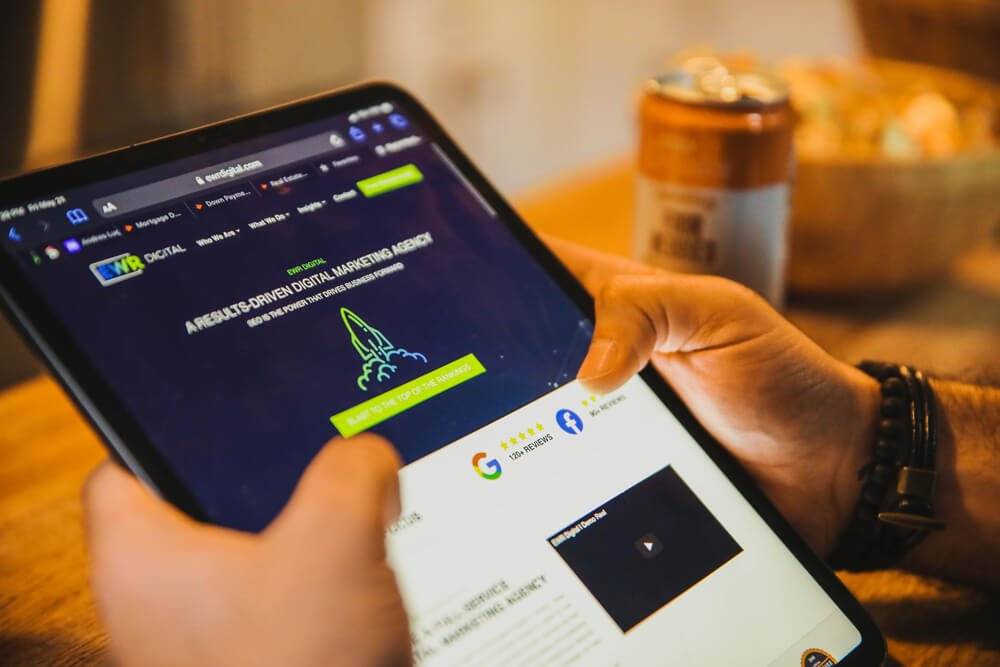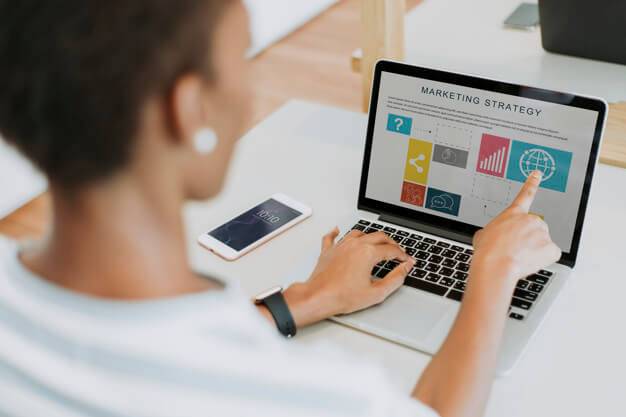
There are several reasons why people consider a website makeover. Often it’s because their website feels and looks out of date. In other cases, they need to update their corporate image or launch a new product line.
That being said, if you want to get the highest benefit out of your website renovation project, take a closer look at the top 21 factors to evaluate before a web redesign project.
Get Clear on Your Marketing Metrics
Before splurging money on a website makeover project, you need to figure out your website’s purpose. For instance, certain landing pages are meant to sell stuff, while others are intended to collect leads and entice potential customers to contact you for more information. Certain pages are exclusively created to offer customer support.
The main takeaway is this — you will see a greater impact from your website redesign project if you set some time aside to define your KPIs – bounce rate, load speed, repeat visitors, and so on. Nailing down these KPIs with your redesign ensures that your website meets its purpose and the changes to enhance the outcome.
In addition, design your website so that your website sees an improvement in bounce rate because a high bounce rate will have you missing out on a ton of leads and customers or clients.
Define Your Target Audience
When it comes to your business, you need the right customers. Your design should be custom-made to reflect your ideal target audience’s pain points, needs, and motivations. It’s never a good idea to target everyone and please everyone.
Lay out the design and the copy on your site in such a way that your – target audience immediately feels as though you are a match made in heaven for them.
Consider Adding an Explainer Video
Explainer videos are known to improve conversion rates. In fact, 83% of businesses say their homepage explainer video is effective. And 95% of people have watched an explainer video to learn more about a product or service
So, if you’re investing in a web design project, it might be in your best interest to create an explainer that gives the site visitor an intuitive understanding of what your product or service is all about.
Create Relevant Content
Don’t just change the design on your website. You need to change the messages on it, too. Try to fill your pages with enough content so that users don’t feel confused and they’re able to understand the range of services/products offered by your business easily.
Do some keyword research before laying out the content on the many pages of your site. Incorporate those keywords because they’ll help your page rank on Google.
Study Your Competition
You can find your competitors through Google My Business Listings if you’re a local business. Also, be sure to check out various online directories because it’s very likely that you’ll be able to see your competitor’s websites there. It’s not enough to check out competitor websites; you’d want to audit their traffic source.
What kind of traffic source are they using to send people to their websites? Examine their value proposition and their positioning in the market, and think of ways in which you can do it better.
Mobile-Friendly and Responsive Design
According to Statista, more than half of global website traffic comes from mobile devices, which means that if you don’t take the time to make your website mobile-friendly, people won’t have a great user experience. You’ll want to instruct your web designer to make your website mobile-friendly and responsive.
Image Optimization
It’s crucial that the images installed on your website are optimized. Otherwise, your site loading times will get affected. And this can negatively affect SEO. TinyPNG and Compress JPEG are two excellent tools for this.
Longer site loading times will mean that people will have to wait longer to access your website. Longer site loading is likely to result in higher bounce rates and can potentially harm your SEO rankings. For that reason, people either use plugins to optimize their images or other image optimization tools that are freely available on the internet.
Selecting The Right Content Management System
Choosing the right content management system is pretty important. The most popular and widely used CMS is WordPress; it’s easy to use and offers a lot of flexibility when it comes to design.
Add to that the fact that nothing beats WordPress if you’re trying to rank your content on Google. Anyway, you will want to sit together with your web designer, ask for a consultation and get more insights on which CMS can help you achieve your business goals.
Budgeting
Web redesign projects can cost a pretty penny. It’s crucial that before hiring a web designer, you map out exactly what kind of web renovation project you want to invest in and what sort of budget you might have for that. Custom web design projects will cost you more, while web design projects based on existing templates will be relatively cheaper. Complex custom web design projects can cost as much as $10,000 – $15,000.
Your budget might also need to be increased if there’s complexity associated with your web design project or if you need design work done for a large number of pages. In addition to setting money aside for web development and web design, you’ll also need to set money aside for marketing services like SEO and copywriting — especially if you don’t have anyone in your team to help you out with that.
Sprinkle Social Proof
Social proof is divine. Sprinkle social proof all across your website content. Social proof can help you increase brand loyalty and give visitors more reasons to support your business. There are several ways to add social proof to your web property. For starters, you could include photos, logos, or relevant certifications on your home page to give them an idea of all you have to offer.
Also, be sure to plug in your social media pages at the footer section of your website. If appropriate and relevant, namedrop any influencers who use your product or service. Add social sharing options to your blog posts. You’ll also want to link to any case studies that you might have on your website and use that to highlight to visitors that your business is the real deal.
Doing all these will help you build a strong social media presence and let people know that your business is the real deal.
Create Prototypes
Before completing a design makeover job, you might want to create different design prototypes. Creating multiple prototype landing pages will allow you to experiment more, and in the process, you will need more test data and be able to do CRO tests that can help you succeed.
Pro tip: Figma and/or Webflow is great for creating prototypes.
Don’t Leave Out Important Company Pages
It can be easy to get carried away when getting your hands dirty on a website renovation project. In the process, you might forget to add certain pages like bout us, the Privacy policy page, and other relevant and essential company pages.
Setup Google Analytics
Another thing you’ll want to do is set up Google Analytics. Google Analytics will help you get invaluable first-hand data, and you will be able to assess the performance of your new website better. Plus, it might be good to set up heat map plugins that will offer you insights into how people interact with your site’s design and copy.
Ongoing Maintenance Costs
If your web design project involves developing a custom theme, you’re likely to need ongoing maintenance support from your developers. It’s a good idea to keep that in mind when investing in a web renovation project in the first place. Ideally, you will want to keep a spreadsheet to keep track of all associated costs that you’ll incur when you invest in a website makeover.
Consistency For User Experience
Another factor that often goes overlooked in web design projects is that your web design must be consistent throughout. This consistency is also called typography. It’s the use of type in a design. Typography’s goal is to build a better meaning by thoughtful and intentional choice of font, color, size, alignment, layout, and other factors that impact the design of type on a page
It ensures that your site appears coherent and functions beautifully across all the elements – headers, sidebars, footers, navigation bars.
If you’re using buttons of a particular color scheme on one page, you’ll want to use the same color scheme on the other pages as well. You’ll also want to stay consistent with the paragraph fonts and the headline fonts you are using on your content pages.
Leaving Room for Scalability
Just because you want a certain number of pages on your website today doesn’t mean that the same will be applicable a few years from now. You want to leave room for scalability when designing your websites. That way, you can add more pages to your website in the future if needed.
Easy-To-Use Navigation Bar
Your web redesign project should be engineered to promote user experience. You can give your site visitors a great user experience by taking the time to plan out an easy-to-understand, intuitive navigation bar. You should add all the important web pages in the header and the footer.
Strong Hosting Provider
If you’re not partnered with a strong hosting provider, investing in web design might be quite meaningless. Without strong hosting, your site loading times will be long, and this will cause friction in the customer journey and might make prospects leave. SiteGround, WPEngine, and Bluehost are some of the best providers.
Planning Out the Customer Journey
When getting a web redesign job done, it’s vital that you take the time to map out a customer journey. Ideally, you’ll want to create distinct buyer personas of your ideal target audience, and you want to think of the journey you want them to take.
Think about the pages you want to send them and what copy you want to use on those pages. Think of what call to action will best motivate them to take your desired action. You also need to consider the stage of awareness of your market and the traffic source.
While this might sound like a lot of work, taking the time to plan out your customer journey will help you crush it with your online marketing efforts.
Avoiding Copyright Issues
Another important element that you will want to remember in the back of your mind is that you need to avoid copyright issues like the plague. You should never copy-paste content directly from competitor sites, as this can result in Google penalties and a consequent drop in organic traffic.
In a similar vein, you will want to source your images from copyright-free stock photo sites like Pixabay and Pexels. If you want your design to have that extra oomph, you might want to consider paying for premium stock photos.
Reputation And Track Record
Last but not least, you will want to choose a vendor with a strong reputation and track record. If you’re hiring a freelance web designer, you’ll want to take the time to examine their portfolio and see what sort of projects they have worked on in the past.
Check out their reviews and get on a call with them to see if you’re the right fit for each other. If you’re hiring an agency, you want to check out their portfolio, LinkedIn profile, Clutch Company profile, and whether they also offer any other form of digital marketing support.
It’s also a good idea to get clarity on the tech stack you’ll be using for your web design projects.
To Wrap It Up
Don’t shy away from changing your site even if it requires a big investment because the results will be so much sweeter. By now, you should have clarity on what factors you need to consider making your web redesign projects a huge hit.
If you still have any further questions, feel free to contact us. If you loved this piece, we encourage you to share it with your network.

